Our Magnetic Universe
October 23, 2017
Science was integrated into my
childhood, since those were the days of the first
artificial satellites and the first men in
space. I was in
eighth grade when
Alan Shepard (1923-1998) piloted the
Freedom 7 spacecraft on May 5, 1961, to become the first
American in space. It was such an
historic event that our
class sat huddled around a small
monochrome television to see it in real time. Because of
launch delays, the timing was good for us, with
lift-off at 9:34 AM
EST.
My fascination with science began far earlier than 1961 when I discovered the magical
action-at-a-distance properties of
permanent magnets. It was amazing to me that you could either
attract, or repel, one magnet with another through empty space. I was also interested to learn about
electromagnets with which you could control these forces with an
electrical switch. My
parents encouraged me by purchase of the
doorbell-style no. 6
dry cell batteries that existed at the time, as my many
experiments drained these quickly.

A no. 6 dry cell battery, the type I used to power my childhood electromagnets.
These batteries were about 6-1/2 inches high and about 2-1/2 inches in diameter. A common use was to power home doorbells, but they were also used in telephone circuits.
They had a capacity of about 40,000 milliamp-hours, which is about five times that of an equivalent carbon-zinc D battery.
(Photo by "Militoy," via Wikimedia Commons
The
magnetism of permanent magnets arises from the
spin magnetic moment of
electrons as they align themselves in the same direction in the
solid. The magnetism of an electromagnet arises from the
electrical current in the
wire, which is movement of electrons in a
circular path. Electromagnetism was discovered by
Hans Christian Oersted (1777-1851), for whom a
unit of magnetic field strength is named.
The
solenoid electromagnet that I made as a child was invented by
William Sturgeon (1783-1850) in 1824. Mine was constructed from bell wire wrapped around a 16
penny (3-1/2 inch, 89 mm)
steel nail, an abundance of which could be found at my house, since my
father was a
carpenter.
Humans were using the
natural magnet,
lodestone, long before they created their own magnetic
ceramics and
alloys. The
Greek philosopher,
Thales, wrote about the attraction of lodestones in the
sixth century BC. Lodestones are magnetized specimens of the
mineral,
magnetite (Fe
3O
4), and these stones are attracted to themselves, and to
iron.
The first modern study of magnetism was done by the
English physician,
William Gilbert (1544-1603). In 1600, Gilbert published
De Magnete,[1] an exposition of magnetism. Not content to just catalog magnetism as known at his time, Gilbert did an experiment to show that the
Earth was a giant magnet. To this end, he created a
sphere of lodestone, which he called a
terrella, as a
model of a magnetic Earth and showed that the magnetic needle of a
compass moving on its surface had the same deflection as a compass on the Earth.
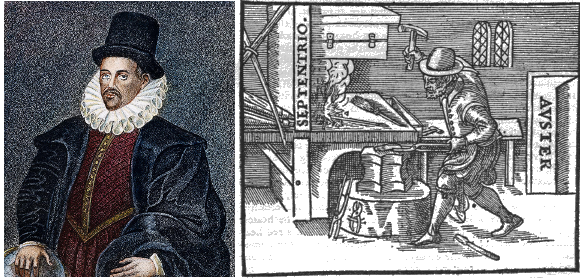
William Gilbert (1544-1603) with a woodcut from his De Magnete. Gilbert's De Magnete contained information on practical magnetism, as this woodcut from his book shows. In this illustration, hot iron is worked on an anvil with its axis aligned north-south in order to magnetize it. The Latin word for North is septentrio, and the Latin word for South is avster/auster). (Gilbert portrait by Charles Henry Granger (1812-1893), via Wikimedia Commons. De Magnete Illustration no. 125, via Wikimedia Commons.)
The
gilbert, a unit of
magnetomotive force, was
named in honor of Gilbert. The gilbert is a
cgs (centimeter-gram-second) unit and not an
SI unit. The SI unit for magnetomotive force is defined as one
ampere flowing in a loop of wire. The
conversion factor from the SI unit of magnetomotive force to gilberts is
10/4π (0.7958), so a gilbert slightly larger.
The compass was known long before Gilbert's time, but not the idea that its deflection was caused by
Earth's magnetic field. Earth's field is comparatively feeble, just 0.25 to 0.65
gauss at its surface, which is small compared to the magnetic field of permanent magnets. The magnetic component of
refrigerator magnets is
barium ferrite (BaFe
12O
19), which has a field strength of up to several thousand gauss. Nonetheless, Earth's magnetic field is sufficiently large to direct
cosmic rays away from Earth's surface. The Earth's magnetic field lines run
longitudinally, so most cosmic rays are deflected to the
poles, where they are sometimes apparent in
auroral displays.

Illustration of an aurora from the 1575 book of Cornelius Gemma on the supernova of 1572.
This book is significant in having been printed at Tycho Brahe's Uraniborg.
From a copy at the University of Oklahoma Libraries, History of Science Collections, via Wikimedia Commons (enhanced image).
The
magnetic field of our Sun originates by a process very similar to how electromagnets generate their fields. The flowing
electric current in the Sun that generates this field is the
convective movement of
plasma.[2] The structure of the Sun's magnetism is quite complex, as the illustration shows. While the polar (north-south) magnetic moment of the Sun (1-2 gauss) is just slightly larger than that of the Earth, the magnetic field at
sunspots (3000-4000 gauss) is equivalent to that of a strong permanent magnet.
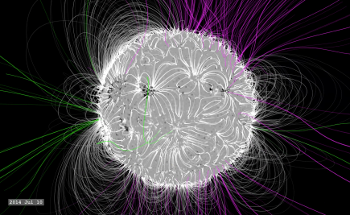
Solar magnetic fields, as depicted in this NASA illustration of the solar maximum in July, 2014.[3]
The complex structure of the Sun's magnetism includes both closed, and open, field lines.
(NASA Goddard Space Flight Center/Bridgman image.)[3]
The Sun's companions are a diverse group of
terrestrial planets and
gas giant, and their magnetic fields are also quite different from one to another. The terrestrial planets other than the Earth do not have a molten
iron-nickel core to generate a field, while the gas giants have sufficient circulation of
metallic hydrogen to generate their fields. I wrote about the metallic hydrogen in the cores of the gas giants in an
earlier article (Saturn and Metallic Hydrogen, July 27, 2015).
Pluto is
technically not a planet, since it's composed of
rock, and
ice, and no
gas. The following table shows the magnetic field strength of the
planets scaled relative to the Earth.[4]
How does the magnetic field of a galaxy of "
billions and billions" of
stars compare to that of a mere
stellar system like our own? Our
Milky Way Galaxy has at least a hundred billion stars, and
infrared observations indicate that there are many more. At the end of the
20th century, the ability to detect the
polarization of
extraterrestrial radio waves allowed good measurements of galactic magnetic fields.[5] Simple
spiral galaxies, such as our
Milky Way, have an overall field of roughly 1-10 microgauss, as compared with Earth's magnetic field of about 300 milligauss. The galactic fields are disappointingly small, which might be a blessing, since the consequence to the Earth of large galactic fields might be unpleasant, perhaps removing the
chances for life.
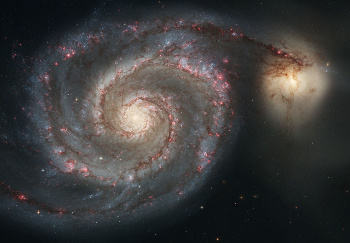
Whirlpool Galaxy (M51/NGC 5194) with its companion galaxy, NGC 5195.
The Whirlpool Galaxy, located in Canes Venatici, is a classic spiral galaxy.
(NASA/ESA image, via Wikimedia Commons. Click for larger image.)
Have galactic magnetic fields changed much as the
universe evolved? That question has been answered by a recent study of the magnetic field of a nearly five billion years old galaxy by a large international team of
radio astronomers.[6-10]
Research team members were from the
Max Planck Institute for Radio Astronomy (Bonn, Germany), The
National Radio Astronomy Observatory (Socorro, New Mexico), the
Cavendish Astrophysics Group (Cambridge, UK), the
University of Toronto (Toronto, Ontario, Canada),
Rutgers University (Piscataway, New Jersey), and the
University of Wisconsin (Madison, Wisconsin). This feat was accomplished through a fortuitous
gravitational lensing of a distant
quasar that allowed a measurement of the polarization of light through the galaxy.
According to the
Big Bang theory, initially, there were no magnetic fields in the universe, so
astrophysicists wonder when and how magnetic fields arose.[9] One
theory supposes that young galaxies have an initially weak and tangled magnetism that becomes stronger and more organized over time.[10] The magnetic fields observed for nearby galaxies are thought to have grown from a seed field via the
dynamo effect.[6] One way to settle this question is to compare a distant, and therefore younger, galaxy to those of our present time.[6] Says
Ellen Zweibel, a
professor of
astronomy at the University of Wisconsin–Madison and a
co-author of the research, "By catching magnetic fields when they're so young, we can rule out some of the theories of where they come from."[9]
The galaxy for which the magnetic field was measured is 4.6 billion light-years away, existing at a time when the universe was about two-thirds of
its current age.[8-9] Determining the magnetism of a distant galaxy is too difficult, but a cosmic
accident made this observation possible. That accident was the alignment of a more distant quasar behind the galaxy that allowed the
gravitation of the galaxy to bend the quasar light to produce two quasar images by a principle called
gravitational lensing (see figure). Gravitational lensing both bent and magnified the light from the distant quasar.
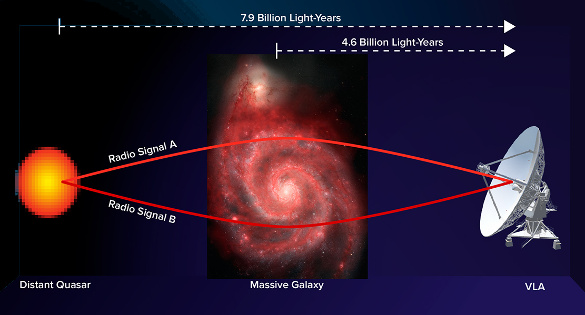
Artist's conception of the gravitational lens arrangement that allowed radio astronomers to measure a 4.6 billion year old galaxy's magnetic field. NRAO image, credits to Bill Saxton, NRAO/AUI/NSF; NASA, Hubble Heritage Team, (STScI/AURA), ESA, S. Beckwith (STScI). Additional Processing: Robert Gendler.
The different quasar images sample different parts of the lensing galaxy. Says
Sui Ann Mao, an astronomer at the Max Planck Institute for Radio Astronomy and lead author of the
paper describing the observation, "Having multiple lensed images of the background quasar to probe along different sight lines through the lensing galaxy is the key to getting the measurement we have here."[10] The measurement is made using the
Faraday effect by which the
oscillation plane of
electromagnetic radiation is
rotated by a magnetic field.[10] Observations were made with the 27
radio telescopes of the National Radio Astronomy Observatory's
Very Large Array in
New Mexico whose
signals were combined to act as a single, enormous telescope.[9-10]
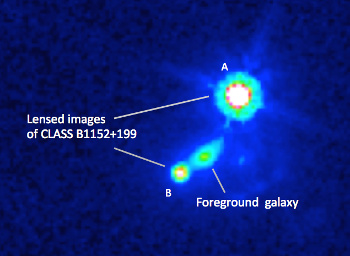
Hubble Space Telescope image of the gravitational lensing system, the foreground galaxy splitting the background quasar into two images, "A" and "B."
Nasa image/Sui Ann Mao et al.
The observations revealed that the magnetism of this early galaxy (
redshift (z) = 0.439) is quite similar to that of our Milky Way in both the field strength and its alignment, having field lines that twist in
spirals around the galaxy's
axis of rotation.[6,8,10] Thus, it appears that galactic magnetism appears relatively early, and it does not grow slowly over time.[10] Says Mao,
"The results of our study support the idea that galaxy magnetic fields are generated by a rotating dynamo effect, similar to the process that produces the Sun's magnetic field... However, there are other processes that might be producing the magnetic fields. To determine which process is at work, we need to go still farther back in time - to more distant galaxies - and make similar measurements of their magnetic fields."[8]
References:
- William Gilbert, "De Magnete," 1600 (original Latin); English translation. The illustration is from Book III, Chapter XII.
- Understanding the Magnetic Sun, NASA Goddard YouTube video, January 29, 2016.
- Sarah Frazier, "NASA: Understanding the Magnetic Sun," NASA's Goddard Space Flight Center Web Site, January 29, 2016.
- Planet Tables, Planets: Physical Characteristics, Astronomy Notes by Nick Strobel.
- Rainer Beck and Richard Wielebinski, "Magnetic fields in galaxies," arXiv, September 17, 2015.
- S. A. Mao, C. Carilli, B. M. Gaensler, O. Wucknitz, C. Keeton, A. Basu, R. Beck, P. P. Kronberg, and E. Zweibel, "Detection of microgauss coherent magnetic fields in a galaxy five billion years ago," Nature Astronomy (August 28, 2017), doi:10.1038/s41550-017-0218-x.
- Supplementary Information for Ref. 6 (PDF File).
- VLA Reveals Distant Galaxy’s Magnetic Field, NRAO Press Release, August 28, 2017.
- Erika K. Carlson, "Magnetic fields in distant galaxy are new piece of cosmic puzzle," University of Wisconsin Press Release, August 30, 2017.
- Record-breaking Galaxy Five Billion Light-Years Away Shows We Live in Magnetic Universe, The Dunlap Institute for Astronomy & Astrophysics at the University of Toronto Press Release, August 28, 2017.
Linked Keywords: Science; childhood; artificial satellite; outer space; eighth grade; Alan Shepard (1923-1998); Mercury-Redstone 3; Freedom 7 spacecraft; American; history; historic; classroom; black-and-white; monochrome; television; launch vehicle; takeoff; lift-off; Eastern Time Zone; EST; action-at-a-distance; permanent magnet; force; attract; repel; electromagnet; electrical switch; parent; doorbell; dry cell; battery; experiment; charge cycle; drain; childhood; inch; diameter; telephone; circuit; battery capacity; ampere; milliamp; hour; carbon; zinc; D battery; Wikimedia Commons; magnetism; spin magnetic moment; electron; solid; electric current; wire; circle; circular; Hans Christian Oersted (1777-1851); unit of magnetic field strength; solenoid; William Sturgeon (1783-1850); penny (unit); steel; nail (fastener); father; carpenter; human; nature; natural; lodestone; ceramic; alloy; ancient Greek philosophy; Greek philosopher; Thales; 6th century BC; sixth century BC; mineral; magnetite; iron; English people; physician; William Gilbert (1544-1603); De Magnete; Earth; sphere; terrella; physical model; compass; woodcut; magnetism; iron; hot working; anvil; north; south; Latin; Charles Henry Granger (1812-1893); gilbert (unit); magnetomotive force; scientists whose names are used as non SI units; cgs (centimeter-gram-second) unit; International System of Units; SI unit; conversion factor; Earth's magnetic field; gauss (unit); refrigerator magnet; barium ferrite; cosmic ray; longitude; longitudinal; geographical pole; aurora (astronomy); auroral display; supernova of 1572; Tycho Brahe; Uraniborg<; University of Oklahoma Libraries; stellar magnetic field; magnetic field of our Sun; convection; convective; plasma; sunspot; solar magnetic field; NASA; solar cycle; solar maximum; field line; NASA Goddard Space Flight Center; terrestrial planet; gas giant; iron-nickel core; metallic hydrogen; Pluto; technically not a planet; rock; ice; gas; planet; Mercury; Venus; Mars; Jupiter; Saturn; Uranus; Neptune; billions and billions; star; Solar System; stellar system; Milky Way Galaxy; infrared; 20th century; polarization (waves); radio astronomy; extraterrestrial radio wave; spiral galaxy; Milky Way; abiogenesis; Whirlpool Galaxy (M51/NGC 5194); NGC 5195; Canes Venatici; universe; chronology of the universe; radio astronomer; research; Max Planck Institute for Radio Astronomy (Bonn, Germany); National Radio Astronomy Observatory (Socorro, New Mexico); Cavendish Astrophysics Group (Cambridge, UK); University of Toronto (Toronto, Ontario, Canada); Rutgers University (Piscataway, New Jersey); University of Wisconsin (Madison, Wisconsin); gravitational lens; gravitational lensing; quasar; Big Bang theory; astrophysics; astrophysicist; theory; dynamo; Ellen Zweibel; professor; astronomy at the University of Wisconsin–Madison; co-author; age of the universe; serendipity; accident; gravitation; artist's conception; Bill Saxton; NRAO/AUI/NSF; NASA, Hubble Heritage Team, (STScI/AURA), ESA, S. Beckwith (STScI); Robert Gendler; Sui Ann Mao; scientific literature; paper; Faraday effect; transverse wave; oscillation plane; electromagnetic radiation; rotation; rotated; radio telescope; Very Large Array; New Mexico; signal; Hubble Space Telescope; redshift (z); spiral; axis of rotation.